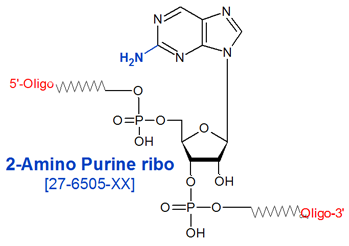
Modification : 2-Amino Purine ribose
Catalog Reference Number
Category
Modification Code
5 Prime
3 Prime
Internal
Molecular Weight (mw)
Extinction Coeficient (ec)
Technical Info (pdf)
Absorbance MAX
Emission MAX
Absorbance EC
27-6505
RNA Oligo Synthesis
[2-A-rP]
Y
Y
Y
329.21
14.5
PS27-6505.pdf
-
-
-
| Catalog No | Scale | Price |
| 27-6505-05 | 50 nmol | $527.00 |
| 27-6505-02 | 200 nmol | $527.00 |
| 27-6505-01 | 1 umol | $659.00 |
| 27-6505-03 | 2 umol | $885.00 |
| 27-6505-06 | 5 umol | $2,965.50 |
| Discounts are available for 2-Amino Purine ribose! |
| Modification* Discount Price Structure |
|
1 site/order
|
List price
|
|
2 sites/order
|
10% discount
|
|
3 sites/order
|
20% discount
|
|
4 sites/order
|
30% discount
|
|
5-9 sites/order
|
50% discount
|
|
10+ sites/order
|
60% discount
|
|
*Exceptions apply
|
Deletion of the O6 carbonyl group of guanosine results in
2-aminopurine riboside (2-AP). The hydrogen bonding pattern of the 2-aminopurine nucleobase (N1 acceptor, H-N2 donor) is isomeric with that of adenosine (N1 acceptor, H-N6 donor).
2-Amino Purine (2-AP) is a fluorescent molecule that is classified as an adenine and guanine analog, and thus can pair with both thymine and cytosine bases (1). It is an attractive choice for use as a probe in nucleic acid secondary structural studies, both because its fluorescence is highly sensitive to the nature of the local environment, and because it usually does not significantly affect duplex stability (2). Examples include the hairpin-loop structure of the (CAG)8 repeat, involved in several neurodegenerative disorders—2AP substituted for A (3), the G-quadruplex telomeric structure [AGGG(TTAGGG)3]—2AP substitute for A (4). 2-AP also has been used to characterize the effects of DNA mismatch repair on mutagenesis induced by several different nucleoside analogs (5).
2-Amino purine nucleoside allows the study of the role of exocyclic functional groups, base stacking, and hydrogen bonding patterns in purine-containing nucleic acids. For example, replacement of guanosine residues with 2-AP in the core region of hammerhead ribozymes was useful in determining their role in stabilizing the transition state of ribozyme cleavage (6). The nature of hydrogen-bonding between G-A mismatches in RNA internal loops was studied with 2-AP (7). The role of hydrogen-bonding and stacking interactions in the stability of GNRA loops was probed using 2-AP substitutions (8). The thermodynamic parameters for RNA loops of the type (A)n were determined using time-resolved spectrofluorimetry on RNAs bearing 2-AP residues in place of A residues, since 2-AP is blue fluorescent and was found to have properties in the (A)n region that were otherwise very similar to adenosine (9). In this sense, 2-AP can be used as a non-invasive conformational probe in RNA studies. Of the different phosphoramidites that have been used for 2-aminopurine riboside incorporation into RNA oligonucleotides (6-10), we have chosen to offer 2-Aminopurine riboside CEP in the particular form shown (6,9) which appears to offer the best results in RNA synthesis yield and purity.
References
Jean JM, Hall KB (2001).
"2-Aminopurine fluorescence quenching and lifetimes: role of base stacking". Proc. Natl. Acad. Sci. U.S.A. 98 (1): 37-41. doi:10.1073/pnas.011442198.
1. Negishi, K.; Bessho, T.; Hayatsu, H. Nucleoside and nucleobase analog mutagens.
Mutat. Res. (1994),
318: 227-238.
2. Ballin, J.D., et al. Local RNA Conformational Dynamics Revealed by 2-Aminopurine Solvent Accessibility.
Biochemistry (2008),
47: 7043-7052.
3. Degtyareva, N.N.; Reddish, M.J.; Sengupta, B.; Petty, J.T. Structural Studies of a Trinucleotide Repeat Sequence Using 2-Aminopurine.
Biochemistry (2009),
48: 2340-2346.
4. Kimura, T.; Kawai, K.; Fujitsuka, M.; Tetsuro, M. Monitoring G-quadruplex structures and G-quadruplex-ligand complex using 2-aminopurine modified oligonucleotides.
Tetrahedron (2007),
63: 3585-3590.
5. Negishi, K.; et al. Binding specificities of the mismatch binding protein, MutS, to oligonucleotides containing modified bases.
Nucleic Acids Res. Supplement No. 1 (2001), 221-222.
6. Tuschl, T.; Ng, M. M. P.; Pieken, W.; Benseler, F.; Eckstein, F. Biochemistry 1993, 32, 11658-11668.
7. SantaLucia, J., Jr.; Kierzek, R.; Turner, D. H. J. Am. Chem. Soc. 1991, 113, 4313-4322.
8. Wörner, K.; Strube, T.; Engels, J. W. Helv. Chim. Acta 1999, 82, 2094-2104.
9. Zagorowska, I.; Adamiak, R. W. Biochemie 1996, 78, 123-130.
10. Doudna, J. A.; Szostak, J. W.; Rich, A.; Usman, N. J. Org. Chem. 1990, 55, 5547-5549.
- 2-Amino Purine ribose
